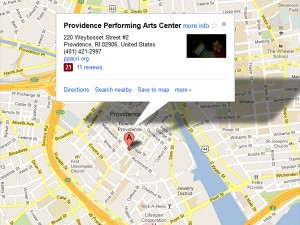
The 26-year-old freelance writer from Providence wasn’t being rude. She had a spot in the “tweet seat” section at the Providence Performing Arts Center.
The downtown theater is now setting aside a small number of seats — in the back — for those who promise to live-tweet from the performance using a special hash tag. They might offer impressions of the set, music or costumes, lines of dialogue that resonate with them or anything else that strikes them, really.
At “Million Dollar Quartet,” based on the true story of a 1956 recording session that united music greats Johnny Cash, Elvis Presley, Jerry Lee Lewis and Carl Perkins, PPAC for the first time had cast members tweeting from backstage, too.
A growing number of theaters, including some on Broadway, have been experimenting in recent years with tweet seats and other real-time uses of social media as they try to figure out the relationship between the stage and the smartphone.
Some insist the theater should remain a sacred, technology-free place and that allowing the use of phones during a show — even discreetly — only serves as a potential distraction for other patrons. But others say theaters can’t afford not to engage the digital generation, and that the way performances were once enjoyed, in a vacuum, doesn’t hold up anymore.
“I think that it’s important that PPAC and cultural institutions in general kind of jump on the social media bandwagon and learn to engage a broader audience,” said Bertness, who runs the blog The Rhode Islander and is such a big Johnny Cash fan that she showed up to the performance wearing all black. “I think it’s such a valuable tool.”
Scott Moreau, an understudy for the role of Johnny Cash, hadn’t ever tweeted from backstage during a performance. He tried to provide a glimpse of what life’s like on the tour, which he likened to the special features on a DVD. He said he enjoyed getting instant feedback from the tweeters — feedback he shared with other cast members.
“It makes it feel a lot more personal,” Moreau said.
A picture of Moreau that was tweeted out from backstage — he was tweeting in it himself — prompted someone in the tweet seats to declare that’s what the Man in Black would have looked like, with an iPhone.
Other theaters are also trying different digital ways to engage with patrons. In Boston, the Huntington Theater plans to introduce a “Twittermission” where an artist affiliated with the production, or someone from the theater’s staff, answers questions about the show on Twitter during intermissions. The tweets will also be projected on screens in the theater lobby, according to spokeswoman Rebecca Curtiss.
The theater won’t be introducing tweet seats, though.
“We feel strongly that the experience that an audience member has in our theater should be limited to what they are seeing on the stage,” Curtiss said. “When the lights go down and the show begins, we want the art on stage to speak for itself.”
PPAC isn’t sure yet whether any social media buzz generated by those in the tweet seats will have a measurable effect at the box office. But spokeswoman P.J. Prokop said the theater intends to keep the program through the end of the year, and then evaluate it. Those who sit in the tweet seats get their tickets for free.
Kirsten DiChiappari, who has tweeted three shows there to her nearly 1,400 followers, grew up in New Jersey going to Broadway musicals, plays and the opera. The 41-year-old social media consultant from Bristol sees her live-tweeting as a way to lure people from their living rooms, where many are glued to “horrible reality television.”
“It’s kind of a way to tease people back to support the live arts, the real arts, the original arts,” she said. “I feel like once they go, they’ll go again.”